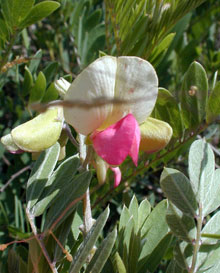GOAT'S RUE
|
 |
| File Size: 86 KB |
|
|
|
Tephrosia virginiana (L. ) Pers.
|
| Ottawa County, Kansas |
| Perennial |
| Height: 8-28 inches |
| Family: Fabaceae - Bean Family |
| Flowering Period: June, July |
|
| Also Called: | | Virginia tephrosia, catgut. | | Stems: | | Erect, 1 to several, mostly unbranched, hairy. | | Leaves: | | Alternate, short-stalked, odd-pinnately compound, 2 to 6 inches long; leaflets 7-31, elliptic to linear-oblong, .5 to 1.25 inch long, to 1/3 inch wide, short-hairy or glabrous above, long-hairy below; margins entire; tips with short, abrupt points. | | Inflorescences: | | Racemes, pyramid-shaped, 1 to 4 inches long, mostly terminal. | | Flowers: | | Calyces bell-shaped, densely silky; corollas papilionaceous, to 3/4 inch long, banner lemon yellow outside, white within, wings and keel rose or pink, all petals fading brownish; stamens 10, filaments united. | | Fruits: | | Pods, 1 to 2 inch long, flattened, slightly curved, sparsely velvety; seeds 6-11, kidney-shaped, dark spotted. | | Habitat: | | Prairies, roadsides, and open woodlands, most abundant in sandy soils. | | Distribution: | | East half of Kansas. | | Forage Value: | | Virginia tephrosia is nutritious and palatable to livestock. It disappears in grazed areas but increases rapidly on summer-rested rangeland. Bobwhite quail and wild turkey consume the seeds. | | Uses: | | This plant was used medicinally by Native Americans to treat rheumatism, pulmonary problems, and hair loss. The roots contain rotenone, which has insecticidal properties. Folklore describes making a tea of goat's rue and pouring it on other plants to kill bugs. |
|
| Goat's rue flower |  | | 54 KB | | Ottawa County, Kansas |
| | Goat's rue inflorescence |  | | 94 KB | | Ottawa County, Kansas |
| | Goat's rue |  | | 150 KB | | Ottawa County, Kansas |
| | Goat's rue pods |  | | 95 KB | | Ottawa County, Kansas |
| | Goat's rue leaves |  | | 65 KB | | Ottawa County, Kansas |
| | Goat's rue |  | | 69 KB | | Reno County, Kansas |
| | | | |
|
|
|
|
|
|








